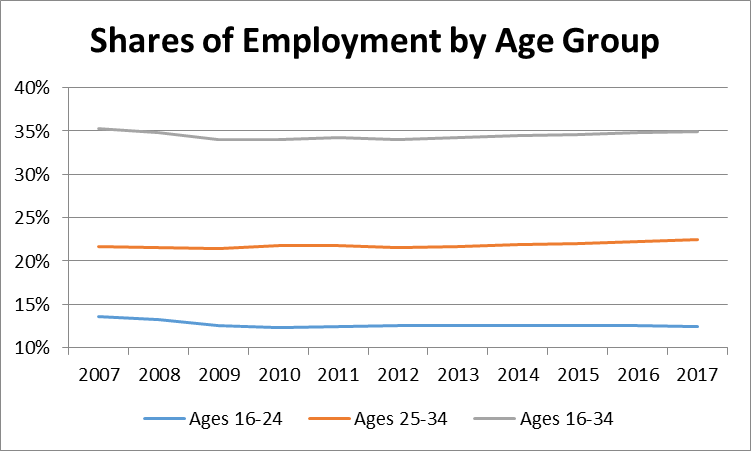August 24, 2017
I messed up earlier this week in discussing the possible impact of demographic changes in the composition of the labor force on the rate of wage growth, but this is an important issue that we should be able to think about clearly. The question is whether the slow pace of wage growth in the last year or two can be explained to any substantial degree by changes in the mix of workers, specifically lower paid younger workers taking the place of relatively higher paid workers who are retiring.
The backdrop is that we are seeing rates of unemployment that are below most estimates of the non-accelerating inflation rate of unemployment (NAIRU). This means that the rate of wage growth should be increasing. In fact, it seems to be slowing. The year-over-year increase in the average hourly wage did pick up a bit in the second half of 2016, going from 2.5 percent, taking the year from January 2015 to January 2016, to a peak of 2.9 percent taking the 12 months ending in December of 2016.
However, instead of rising further as the unemployment rate has continued to fall, the rate of wage growth has slowed modestly in 2017. It was just 2.5 percent in the 12 months ending in July of 2017. It’s even a bit slower if we use my preferred measure, the average wage in the last three months compared to the prior three months. That gets you just a 2.3 percent annual rate of wage growth. So, wage growth is clearly going in the wrong direction from the standpoint of the accepted estimates of the NAIRU.
One response to this seeming anomaly is to argue that wages would be growing more rapidly, except for the high-paid older workers being replaced by lower paid younger workers. I got sloppy on this in my earlier post, but I will try to be clear on the point here. If we are looking to explain a change in a growth rate (an increase or decrease in the rate of wage growth) with a demographic change (the rate at which younger workers are replacing older workers) then we need to see a change in the rate of demographic change. Specifically, if we are arguing that the reason wage growth has slowed rather than increased between 2016 and 2017 we need to show a faster pace of demographic change in 2017 than in 2016. The data will not support this story.
The figure below shows the share of younger workers among the employed from 2007 to 2017.

Source: Bureau of Labor Statistics.
There is a modest increase in the share of workers ages 25–34 among the employed from 2012 to 2017, going from 21.55 percent to 22.46 percent, an increase of 0.9 percentage points over five years. This increase is partially offset by a decrease in the share of workers between the ages of 16–24, which dropped by 0.05 percentage points over this period. Taking the two together the increase in the share of the young in employment over the last five years has been 0.87 percentage points, so there is some plausibility that this has been a factor slowing wage growth over this period.
However, if we focus on the change in the last year, the increase in the share of the young in total employment has been just been just 0.13 percentage points. If we assume that the young workers are paid half as much as the older workers they replace, this demographic change could explain a slowing in wage growth of less than 0.07 percentage points (50 percent times 0.13 percent).
In fact, the demographic change buys even less in terms of an explanation of slowing wage growth, because the increase in the share of younger workers was slightly faster between 2015 and 2016, rising by 0.21 percentage points. So the demographics go the wrong way for explaining a slowdown in wage growth between 2016 and 2017. I do have to qualify this point by saying that it is possible that a more detailed breakdown could show a somewhat different picture.
For example, if there were a tilting within age bands to the lower paid segments (e.g. more 25-year-olds and fewer 34-year-olds), it could show a different story. Also, since we are taking average hourly wages, employment has to be weighed by hours. If the younger workers tend to put in fewer hours, their impact on the average hourly wage would be less. I doubt that a more careful analysis would change the story to any substantial degree, but it is important to note this possibility.
Note: I modified this from an earlier post to take account of the demographic change between 2015 and 2016.







Comments